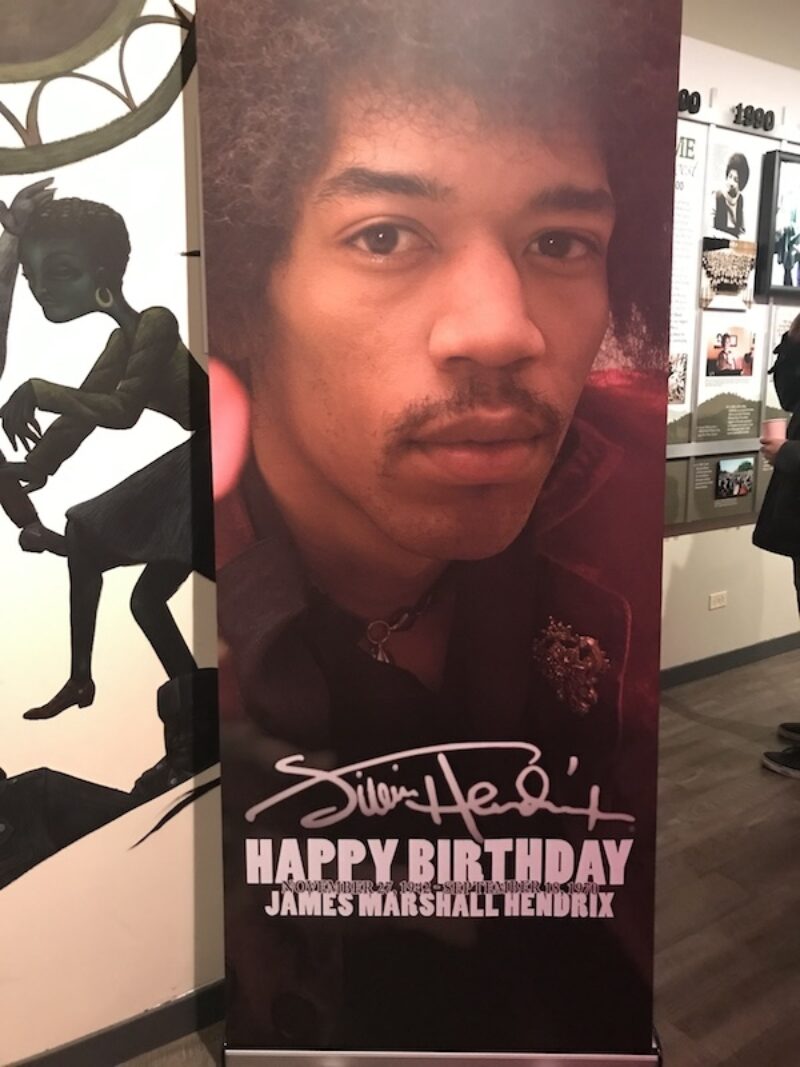The Jimi Hendrix We Didn’t Know
Written by TeenTix Press Corps Newsroom Writer Lark Keteyian, and edited by Teen Editorial Staff Member Anya Shukla!

Jimi Hendrix is a Seattle icon. Or so I'm told. Before going to see Bold as Love: Jimi Hendrix at Home at the Northwest African American Museum, I had never really gotten around to listening to his music. I'm also terrible at museums; I expect them to be stagnant and awkwardly informational. So the combination of a museum with a Seattle superstar I knew next to nothing about was mildly terrifying. I slunk into the exhibit with my head down, afraid all the fans would see the Hendrix-ignorance in my eyes, and prepared to be bombarded with trying-too-hard inspirational quotes.
The exhibit, guest curated by Jackie Peterson, is set up like a timeline, snaking chronologically around the edges of the room. Photographs and glass-encased objects—postcards, the sofa Hendrix slept on while home from tour, his grandmother's hats—drew me in with their quiet connection to this icon. I ended up learning about Hendrix's history almost accidentally: from Seattle, where he was born and spent his childhood, drawing comics and pretending to play guitar on a broom, to mid-60s London, where he almost immediately became a guitar star.
We have all been well-exposed to Hendrix's gritty tabloid side. American audiences didn't know what to make of him—Charlie Cross, Hendrix's biographer, said that Hendrix’s “music was too white to be played on black radio stations, and too black to be played on white radio stations.” As an adult, he struggled with drug abuse, dying of an overdose at 27. From this point of view, he was rock 'n' roll personified—playing his guitar in the face of adversity, doing drugs, living fast, all while dressed in a snazzy military jacket.
We are fascinated by the everyday lives of icons. It's thrillingly weird to see stars shrunk down to our size, but at the same time, there's a desire for all the unknown details to be sensational. There is none of that in this exhibit. The average-ness of the objects—Hendrix's handwriting is messy, and his iconic military jacket is greyed—brings the "greatest guitarist of all time" down to Earth. Statements about Hendrix's need to stay true to himself combined with things you could find in your house make your chest lift. It feels like Jimi Hendrix could be you.
Bold as Love exhibit at the Northwest African American Museum. Photo by Anya Shukla
At the same time, the exhibit is about creating a new rock 'n' roll myth. It emphasizes his American dream-style rise from worn-out couches to sold-out shows in London and the way his fairy-tale family history makes his rise to fame feel inevitable—his grandmother was a chorus girl, his grandfather a stagehand. The exhibit strips away the sex, drugs, and rock 'n' roll and leaves us with a less glittery, unexpectedly relatable Jimi Hendrix.
Bold as Love may not give us Jimi Hendrix in his own words, but it does give us his words, through lyrics and quotes. Before seeing this exhibit, he had existed in a space beyond my articulation, but seeing him talk about hearing Muddy Waters playing guitar for the first time—"I heard one of his records...and it scared me to death because I heard all of those sounds. Wow!"—transformed him for me. There is now solidarity between me and Hendrix, two kids from Seattle whose lives were transformed by music.
It feels like a recreation of the Hendrix I thought I knew, even if really it's just an unearthing, a rearranging. Bold as Love doesn't only show its audience new facets of Hendrix; it provides us with a whole new narrative. This Hendrix is a kid from Seattle who was really good at playing the guitar, and by staying true to himself and his music, managed to revolutionize rock 'n' roll.
This exhibit crept up on me, snuck under my skin. I walked out feeling, unexpectedly, inspired. I felt like Jimi Hendrix could be me. Excuse me while I kiss the sky.
The Teen Editorial Staff is made up of 5 teens who curate the review portion of the TeenTix blog and manage the TeenTix Newsroom. More information about the Teen Editorial Staff can be found HERE.
The TeenTix Press Corps promotes critical thinking, communication, and information literacy through criticism and journalism practice for teens. For more information about the Press Corps program see HERE.



